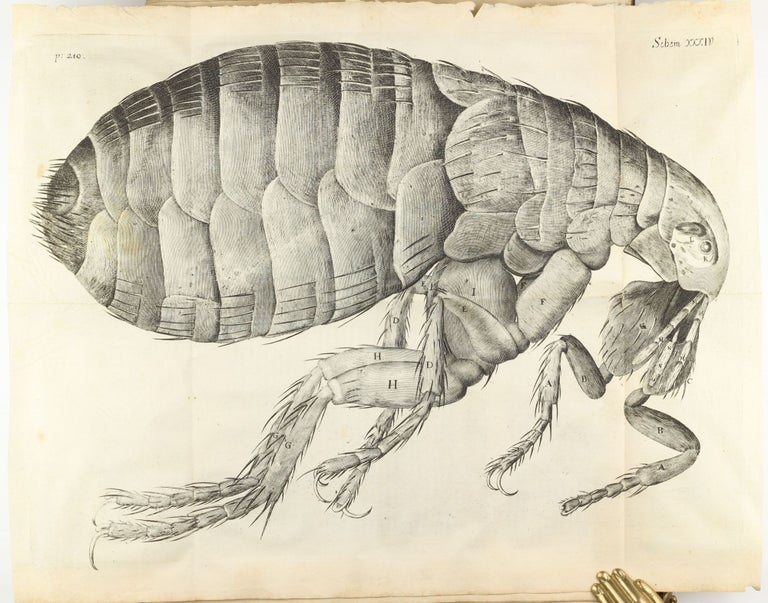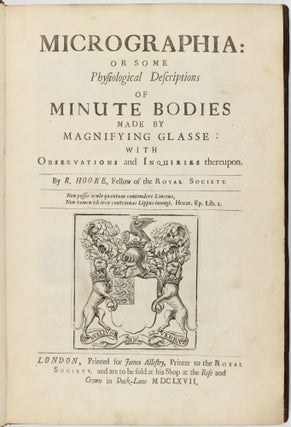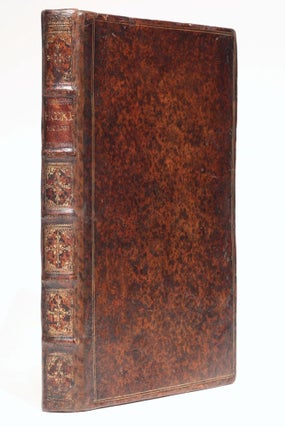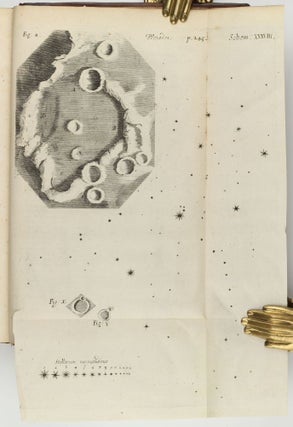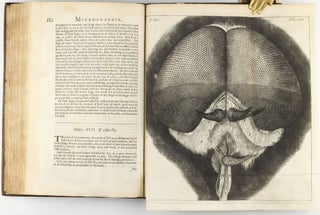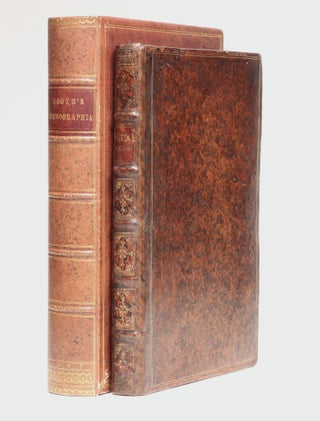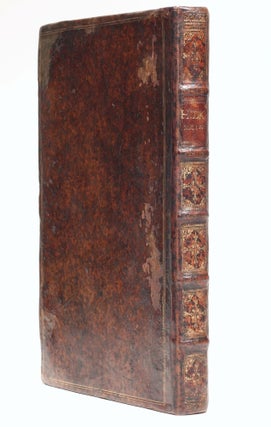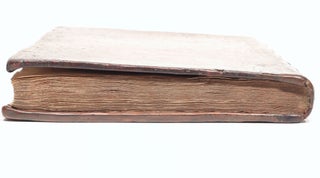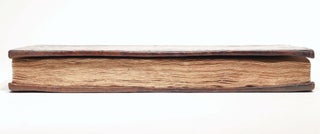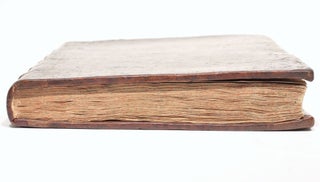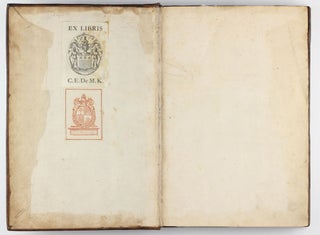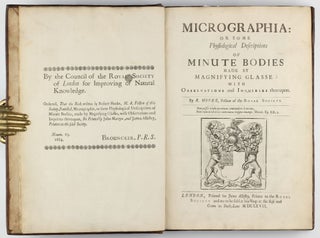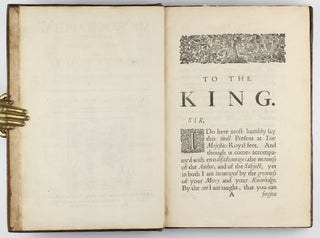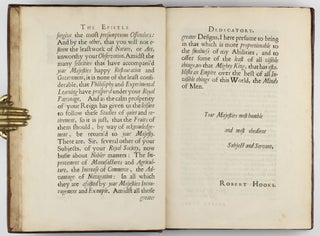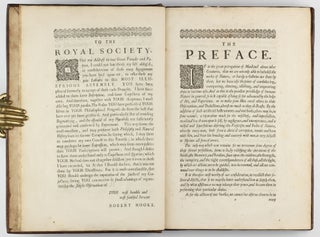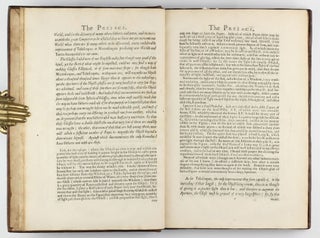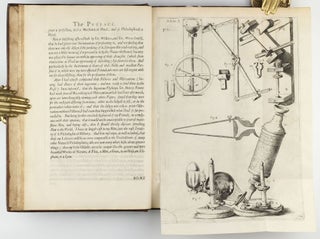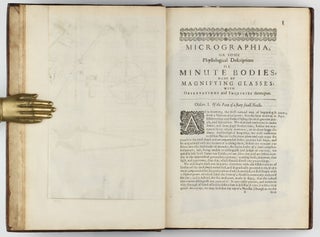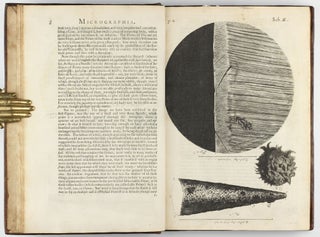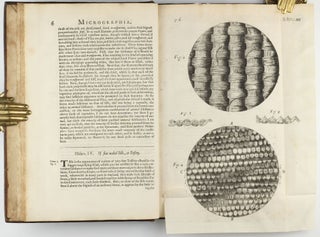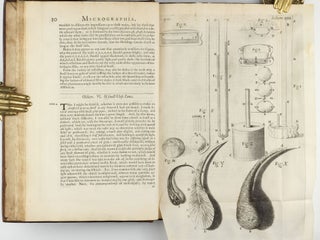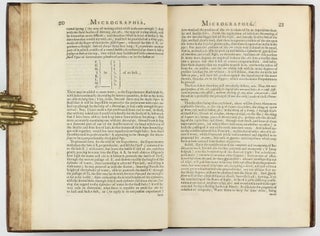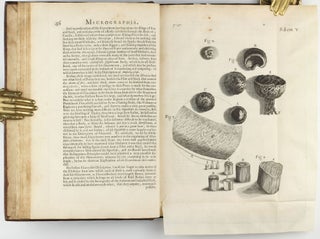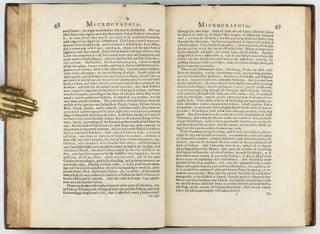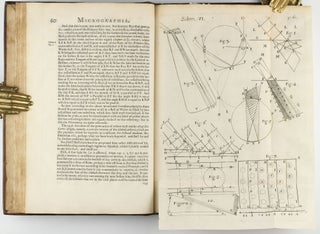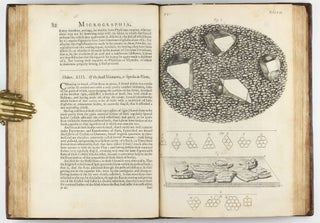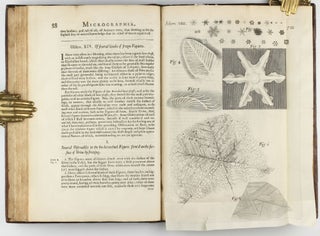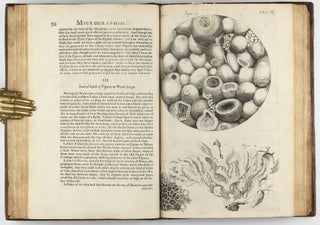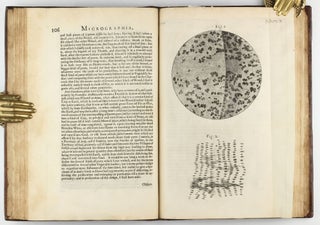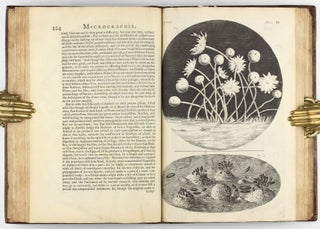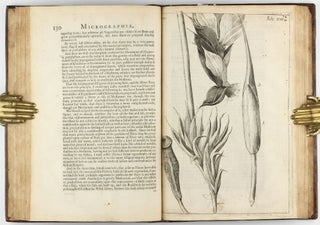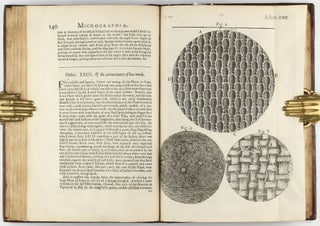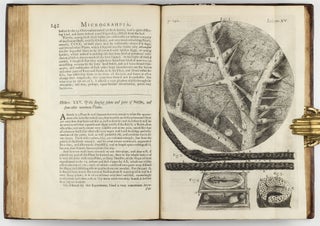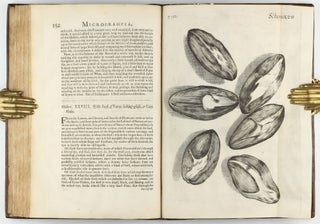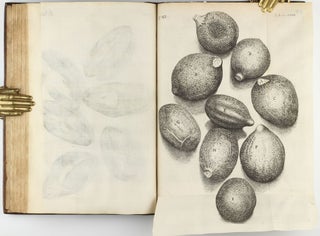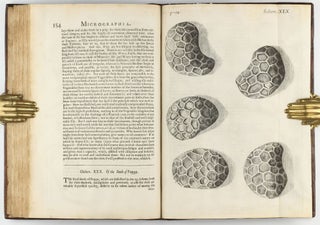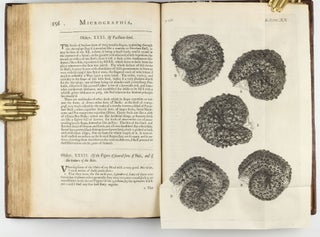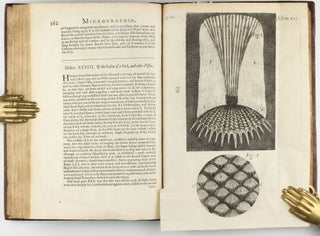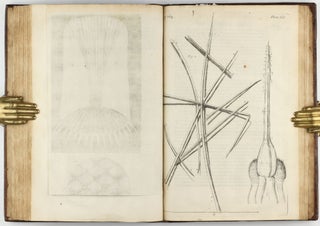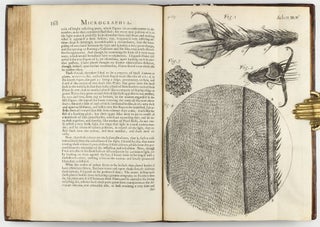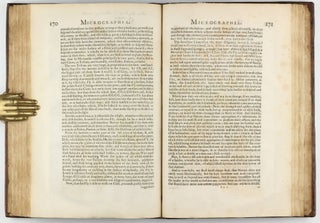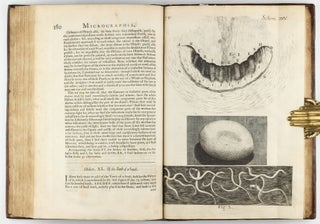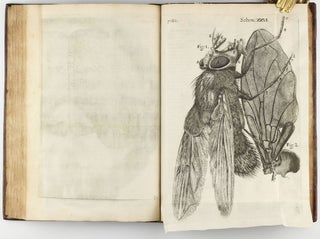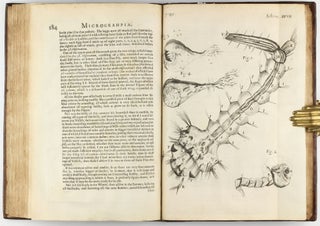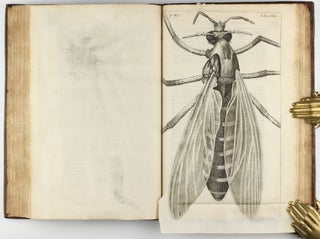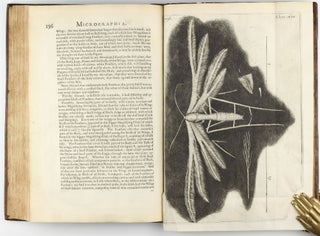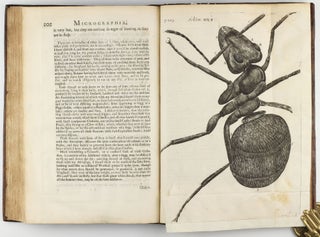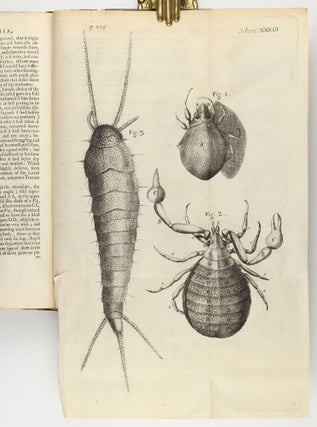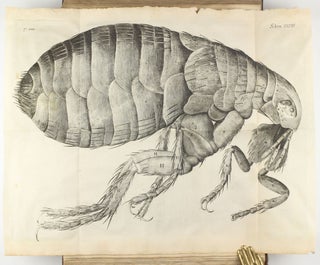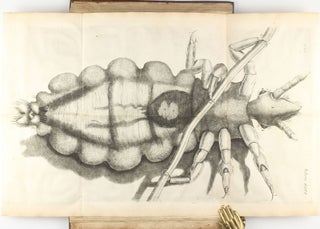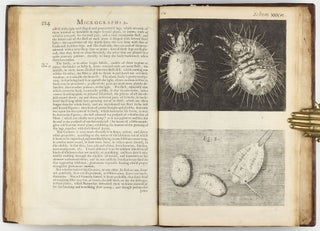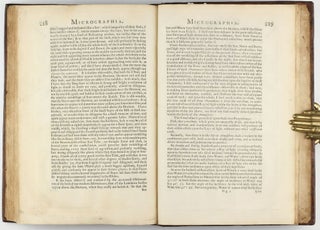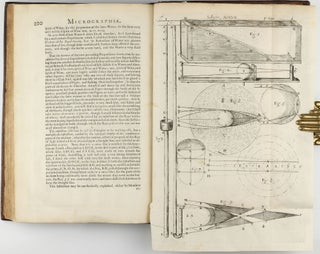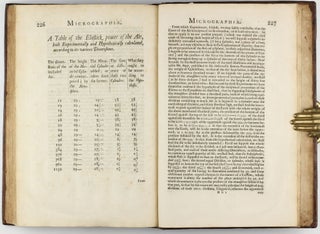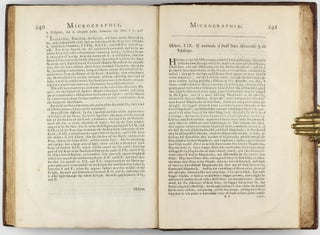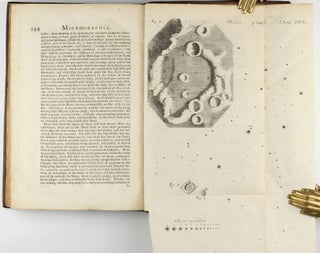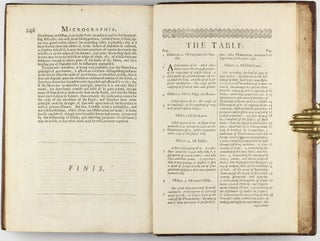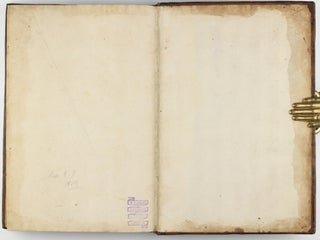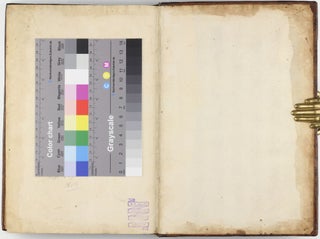Micrographia: or some Physiological Descriptions of Minute Bodies made by Magnifying Glasses with Observations and Inquiries thereupon.
London: Printed for James Allestry, 1667.
1st Edition. Hardcover. Very Good. Item #003613
Folio (299 x 198 mm). [36], 246, [10] pp., title with engraved arms of the Royal Society, imprimatur leaf before title, 38 engraved plates (30 folding of which 2 double-page and mounted on stub), woodcut head-pieces and initials, errata on final page verso. Signatures: [pi]2 A2 a-g2 B-C2 D-2K4 2L-2M2. Contemporary mottled calf, spine with some gilt decoration and gilt-lettered label, boards with gilt double-ruled border, red sprinkled edges, original endpapers (expertly rebacked preserving original spine, edges and corners neatly restored); protected in full-calf custom clamshell box. Text and plates generally quite crisp and clean showing only very minor occasional (mostly marginal) spotting; the title page with minor dust- and finger-soiling at outer margins, occasional short clean tears to folds of plates and to lower blank margin of leaf Ff2, pencil note to p. 170, leaf Q1 with light brown staining of blank fore-margin, small damp-stain at upper blank margin of plate VII. Provenance: John Dautzenberg (red armorial bookplate to front pastedown); Charles Ernest Montchal Kellett (monogrammed armorial bookplate to front pastedown). Excellent, very wide-margined copy. ----
PMM 147, Horblit 50, Dibner 187, Sparrow 105, Norman 1092; Wing H2621, Keynes, A Bibliography of Robert Hooke, 7. FIRST EDITION, SECOND ISSUE. The title-page to this issue has been reset, but except for plate V, which was re-engraved in reverse, the same plates were used as in the first issue. Our copy is exceptionally tall and without a single engraving being affected by trimming, which is rarely found for this work.
"Robert Hooke was one of the most versatile and brilliant scientists of all time, and his contributions to astronomy, optics and all branches of physics, mechanics, technology and architecture are innumerable. In 1662 he was appointed curator of experiments to the newly founded Royal Society (see [PMM]148) and remained at the centre of the English scientific world until his death. He suggested and inspired scientific work in all fields and carried out an immense number of experiments himself. He left comparatively few printed works, of which the Micrographia is the most famous. It contains fifty-seven microscopic and three telescopic observations, beginning with an examination of inorganic matter and proceeding to the investigation of vegetable and animal bodies. Although ostensibly concerned with microscopy, the book includes scientific observations of high importance in several other fields. Hooke's main contribution to biology was in microscopy. In Observation No. 18 he describes the structure of cork, comparing it to a honeycomb, being composed of 'cellulae' with walls bounding the 'cells'. A century and a half later the effective study of 'cells' -- the word was first used here -- led to completely new ideas about the structure of animals and plants. In Observation No. 16 on charcoal Hooke gives his views on combustion: these are very close to those of Boyle ([PMM]141), with whom he collaborated. Observation No. 58 describes the phenomenon of the diffraction of light, this discovery being independent of Grimaldi's nine years before. In Observation No. 17 Hooke writes of the properties of fossils, which he considers to be shells of certain shell-fish 'which either by some deluge, inundation or earthquake. . . come to be thrown to that place'. In Observation No. 4 he makes a reference to the possibility of spinning a kind of 'artificial silk' out of some glutinous substance that may be equivalent to natural silk. In the purely microscopic part of this handsome and copiously illustrated folio, Hooke describes for the first time a polyzoon, the minute markings offish scales, the structure of the bee's sting, the compound eye of the fly, the gnat and its larvae, the structure of feathers, the flea and the louse. He observed sponges, which he defines as animal structures, not plants, comparing their tissue with horn and hair. He saw the plant-like form of moulds. Hooke's other experiments, and in particular his work with scientific instruments, are remarkable. He perfected the compound microscope, which he used for his observations; he invented the wheel barometer and other meteorological instruments; and with his new methods of keeping weather records he has been called the founder of modem meteorology. Hooke worked in cartography and geography (assisting Ogilby and Pitt in creating their atlases), improved watches, and made many contributions to optics, physiology, artificial respiration, geology and palaeontology. He invented an apparatus for diving and depth-sounding, and invented or improved a large number of other scientific instruments. He was also active as a surveyor and architect. . . The magnificent plates, mostly from designs by the author himself, but some probably by Sir Christopher Wren, were reprinted in 1745 and some still appear in nineteenth-century books on microscopy. Today it is recognized that Aubrey was right when he said 'He is certainly the greatest mechanick this day in the world', and some think that Hooke was perhaps the greatest mechanical genius science has ever had." (PMM 147).
"The Micrographia had an immediate, widespread, and lasting success . . . Pepys, who bought it at once and sat up reading it till two in the morning, characterized it as 'the most ingenious book that ever I read in my life.' We are not told that Newton sat up late, but he read it with care, and made copious notes." (M. Espinasse, Robert Hooke, 1956, p 58).
Sold
Delivery time up to 10 days. For calculation of the latest delivery date, follow the link: Delivery times
Lieferzeit max. 10 Tage. Zur Berechnung des spätesten Liefertermins siehe hier: Lieferzeiten


